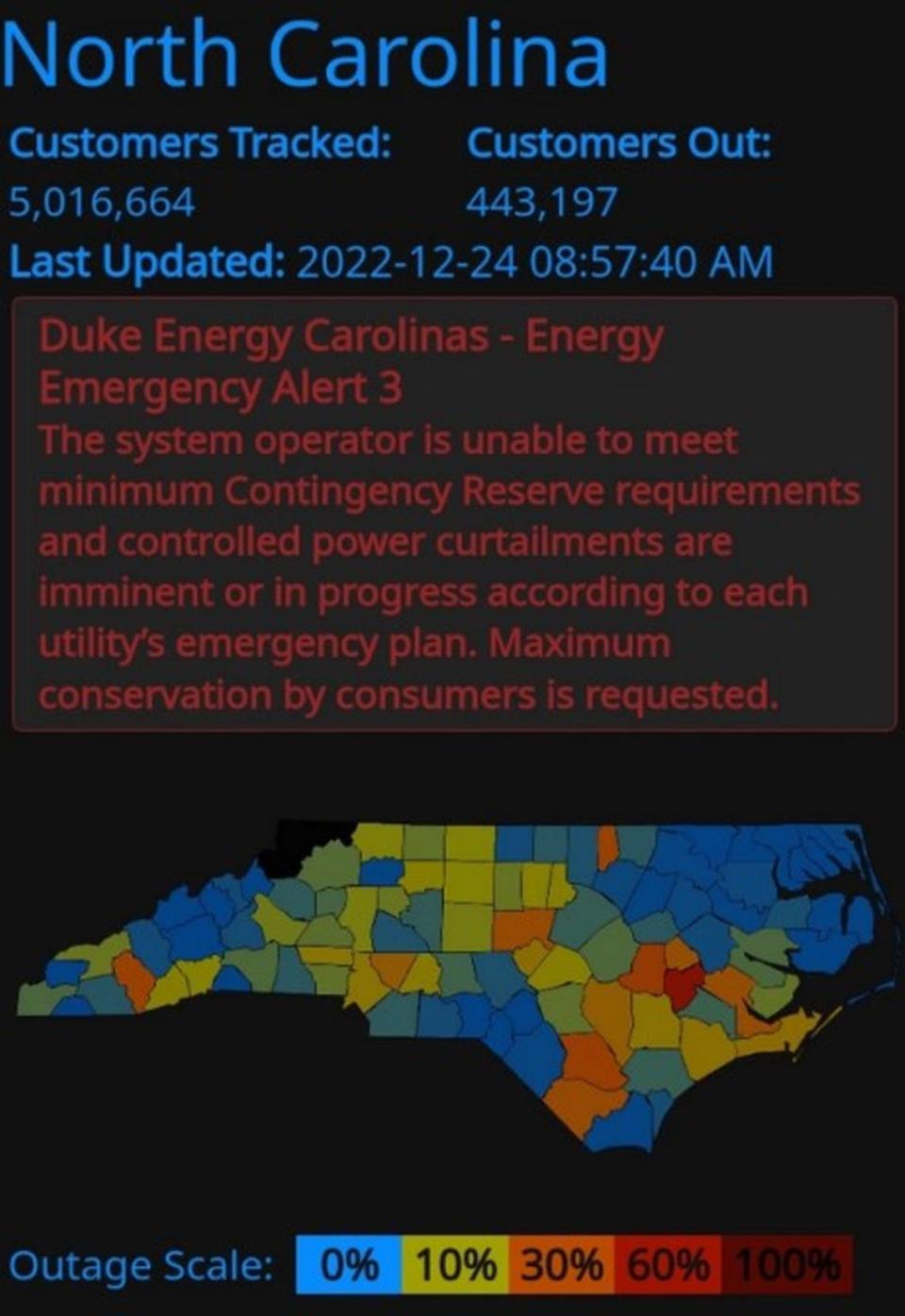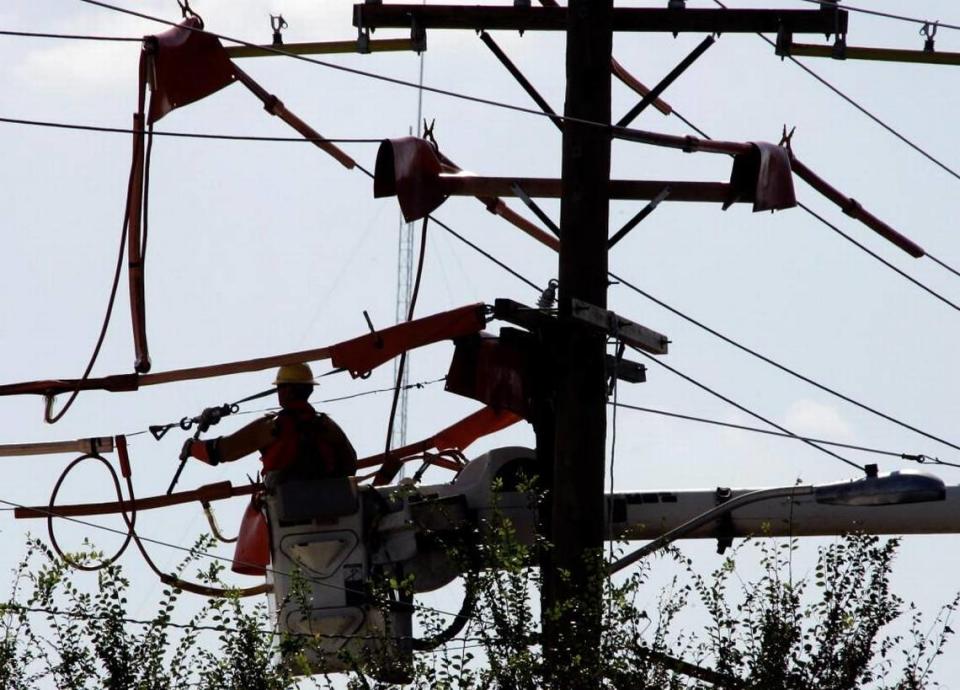Duke Energy had rolling blackouts last Christmas Eve. How it aims to avoid a rerun.
The rolling blackouts Duke Energy enacted last Christmas Eve were the first in North Carolina’s history and have left a lasting impact on the state’s energy policy.
The blackouts raised many tough questions. Regulators wanted to know why the company left customers without power for hours when temperatures were below freezing. Renewable energy advocates quickly noted that it was frozen instrumentation at fossil fuel plants that left some power offline when it was most needed.
Friday, the N.C. Utilities Commission filed an order requiring Duke Energy to provide more details about what happened during Winter Storm Elliott and calling for annual updates describing how the utility plans to keep the power on during future winter storms.
Here’s what’s changed in the year since the power failure and how it could impact where your power comes from in the future.

What happened with Winter Storm Elliott?
On Dec. 24, 2022, Duke Energy officials decided to implement rolling blackouts for the first time in North Carolina history, a step they believed was necessary to protect the grid as demand soared due to Winter Storm Elliott’s freezing temperatures.
“That’s not a small thing. That’s something that we understand — we have a responsibility to deliver reliable power to our customers and that responsibility extends into periods of extreme temperatures,” Jeff Brooks, a Duke spokesman, told The News & Observer.
Other Southeasetern utilities — Louisville Gas & Electric, South Carolina’s Santee Cooper and the Tennessee Valley Authority among them — also implemented rolling blackouts.
Increased demand from the freezing winter storm pushed demand up, stressing the grid as early as the evening of Dec. 23. Then, Brooks said, frozen instrumentation at a pair of Person County coal plants and a natural gas plant in Rockingham County caused those facilities to operate at reduced capacity.
And when Duke sought to purchase power from neighboring utilities and independent power producers, it quickly learned there was none available because of the widespread nature of the storm.
The rolling blackouts affected about 500,000 customers, with some staying in the dark for hours.
What has Duke done?
Brooks outlined a number of steps Duke has taken in response to the winter storm, including:
Updating the company’s models for winter forecasts: Brooks said forecasting electricity demand in the winter is more difficult than in the summer because there’s a separate period of increased demand in the morning hours, as people wake up and their heating systems turn on. Duke’s model, Brooks said, improved as soon as Christmas day in 2023 by inputting demand information from Christmas Eve.
Improving the software the company uses to implement rolling blackouts: Winter Storm Elliott marked the first time that Duke Energy ever had to implement rolling blackouts to protect North Carolina’s larger grid, and it didn’t go well. The software that is supposed to limit blackouts to 15 to 30 minutes before rolling to another customer became overloaded, leaving some customers without power for hours. Brooks said, “While we hope we never have to use it again, we have to be prepared to use it again and we think that if we did, we could deliver a better experience for our customers today than a year ago.”
Previously, Duke had done some power plant maintenance year-round, resulting in power generation being offline during Winter Storm Elliott. This year, Brooks said, the company finished all of its routine maintenance by the first week of December. He said, “All of the plants that we can bring online are available to serve customers in the event that we have very high demand for electricity.”
Working on the company’s communication: A key way to prevent rolling blackouts is to reduce how much power is being used. But, Brooks said, an appeal that goes out at 4 a.m. when grid operators foresee a problem at 6 a.m. is unlikely to be very effective. Duke intends to make the request the evening before an early morning demand spike, a time when turning down thermostats can still have a meaningful difference. In fact, Brooks said, the company did that on Christmas Eve last year and saw people cut down on energy usage on Christmas day.

Will those steps keep the power on?
Severe winter weather this year could again leave Duke and other Southeastern utilities in a perilous spot, according to a winter reliability assessment from the North American Energy Reliability Corp.
NERC is a regulatory agency that seeks to reduce risks to the power grid across the continent.
The regulators noted that while power demand in the Carolinas is usually highest in the summer, winter demand is starting to rise, too.
“Forecasted peak demand has risen while resources have changed little in these areas since Winter Storm Elliot caused energy emergencies across the area in 2022,” the report said. It said utilities in the region have adequate resources for normal winter conditions but are vulnerable to extreme conditions.
The report concluded that load shedding, or rolling blackouts, are unlikely but could become necessary if there is another cold-weather event that covers a broad portion of the continent.
Brooks, the Duke spokesman, said the company is better prepared should a similar winter storm happen this year. He also noted that, fortunately, the forecast for the holidays this year is much warmer than last year’s.
“We have to be ready throughout the whole season, and that takes planing, that takes investment, that takes improvement,” Brooks said. “We heard loud and clear from our regulators, from our customers, that they expect us to improve.”
What is the Utilities Commission asking for?
The N.C. Utilities Commission concluded a yearlong review of Winter Storm Elliott on Friday. The review “identified deficiencies and vulnerabilities made apparent by Duke’s performance during Winter Storm Elliott,” the commissioners wrote, “and notes the continuing risk ... that has been identified by NERC.”
Commissioners filed an order calling for Duke to submit detailed reports within 60 days describing its planned outage protocols, upgrades the company has made at power plants since Winter Storm Elliot, how the company is planning for potential failures of energy purchases during future storms, and how it has changed customer communication protocols.
Duke will also need to file a report each November describing how it’s prepared for the upcoming winter.
Should Elliott change NC’s perception of natural gas?
Duke Energy officials have typically argued that natural gas represents a reliable power source that can be called upon at times when other resources aren’t available.
Chris Carmody, executive director of the Carolinas Clean Energy Business Association, argued that Winter Storm Elliott should have shifted that view. The cold temperatures were forecast more than a week ahead of time, Carmody said, and gas infrastructure still froze.
“If knowing ahead of time doesn’t allow you to prevent gas lines and plants from freezing, that’s not the most reliable source, especially for extreme winter periods,” Carmody said.
Brooks said natural gas needs to be a part of the future, particularly as renewables take on an increasing role. Over the next 15 years, Duke anticipates that the state’s energy demand will increase by about 58,000 gigawatt hours, or as much as Delaware, Hawaii, Maine, New Hampshire and Wyoming use in a single year.
“Natural gas is an excellent resource to be able to deploy in a timely fashion to meet those needs,” Brooks said. “It’s a reliable and efficient resource, but it is not the only resource we’re thinking about.”

Could renewable energy help?
Renewable energy advocates argue that Duke should be turning to renewable sources like solar paired with storage and offshore wind to generate power instead of building additional gas-fired plants.
“Moving to more modular resources like solar and storage and accelerating the development of wind resources will help better balance and mitigate against future outages due to extreme weather, in part because you’re diversifying your resources,” David Neal, a Southern Environmental Law Center senior attorney, told The N&O.
Many of the plants that lost capacity in the Southeast during Winter Storm Elliott saw equipment freeze above their minimum operating temperatures, showing the vulnerability of existing sources, Neal added.
Another way to help on cold winter days would be to invest further in energy efficiency, Neal said.
“When we invest in energy efficiency and make customers’ homes more insulated, less drafty, they’re able to hold their heat for longer so if there is an outage, it takes longer for the house to get cold,” he said.
When the scale of last December’s problem became clear, Brooks said, Duke turned on all of the resources it had available. Those included coal, natural gas and nuclear plants, as well as the company’s pumped hydro storage facility.
Solar wasn’t immediately available, Brooks said, because problems started to rise in the overnight hours.
“As the sun came up, we began to use it more and that helped us exit from those outages,” Brooks said. Without battery storage, “that solar will not be able to help on those cold mornings when the peaks happen before the sun comes up.”
Brooks also noted that Duke plans to use energy efficiency measures to curb its retail sales by about 1%. He said Duke has proposed demand response measures that could limit the amount of power needed by 1.05 gigawatts by 2030, a level that’s about 25% higher than the peak capacity of the Mayo coal-fired powerplant in Roxboro.
How should NC regulators be considering Elliott?
Duke Energy’s Carolinas Resource Plan has mapped out three pathways to achieving net zero greenhouse gas emissions in North Carolina. But the N.C. Utilities Commission is also directed to consider affordability and reliability, and rolling blackouts represent a significant mark against the latter.
The company’s preferred route to net zero would add 11.9 gigawatts of solar energy and 4.3 gigawatts of battery storage by 2035. That’s the second-lowest amount of solar of the three portfolios Duke proposed to the N.C. Utilities Commission and the lowest amount of storage.
That portfolio adds 6.2 gigawatts of new natural gas plants, a step Duke has said is necessary to provide quickly dispatchable power that doesn’t rely on the sun shining or the wind blowing.
Critics have argued that Duke’s preferred route represents a too-gradual transition to renewable energy that seeks to build financially risky advanced nuclear and hydrogen-capable natural gas plants at a time when battery storage, solar and wind energy are already proven technologies.
Neal, of the SELC, said Duke’s not using the outage to shift toward more renewables in its future plans is frustrating.
“It continues to say that it needs to build even more gas-fired power plants in the name of system reliability and is not doing enough to embrace the energy transition at the speed or the scale that’s really necessary both to comply with the carbon emissions reductions requirements in state law but also from a reliability standpoint,” Neal said.
In the medium term, Carmody suggested that it would be better to build additional energy storage like batteries than more natural gas plants. A key benefit of storage, he said, is that any kind of energy generation can be used to put power into it, electricity that can be called upon when it is needed.
“Certainly it would allow renewables to be delivered, even solar energy to be delivered in the middle of the night, but it could be applied to other energy sources, as well,” Carmody said.
This story was produced with financial support from the Hartfield Foundation and 1Earth Fund, in partnership with Journalism Funding Partners, as part of an independent journalism fellowship program. The N&O maintains full editorial control of the work.

